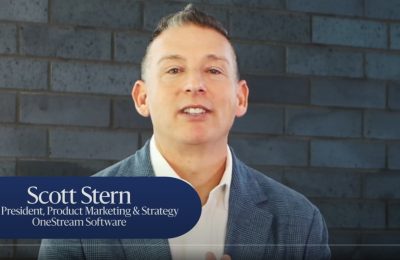This article first appeared on OneStream Software blog pagse by Zach McKeown
Machine learning (ML) has no doubt revolutionized how to handle data in the 21st century. Thanks to the ability to identify patterns and relationships within vast amounts of data, ML has become an essential tool in various fields, including Enterprise Performance Management (EPM).
Traditionally, technology limitations constrained how EPM could be used to monitor, analyze and manage business performance. EPM involves budgeting, forecasting, financial consolidation, reporting and more. Today, ML can significantly improve the accuracy, transparency and agility of EPM processes. How? By automating these activities and providing insights previously impossible to obtain.
Creating Accurate, Transparent & Agile ML-Driven Forecasts
As we shared in the first post of the Sensible ML for EPM blog series, today more than ever, organizations are looking to become more accurate, transparent and agile with their financial plans to stay competitive. And OneStream’s Sensible ML can help. How? It allows users closer to the business to infuse business intuition into the model, which can increase accuracy and ensure all the available information is considered.
Unlike the forecasting capabilities of “most” predictive analytics (which look at prior results and statistics and then generate forecasts based on past events), Sensible ML has unique sophistication. Sensible ML also considers additional business intuition, such as events, pricing, competitive information and weather to help drive more precise/robust forecasting (see Figure 1).

Figure 1: Sensible ML Process Flow
Sensible ML’s speed in responding to evolving business environments offers a clear advantage over traditional approaches. While a statistical-based system means planning teams often wait several weeks – or months! – for the financial and non-financial results needed to produce forecasts that respond to changes, Sensible ML can achieve the same result much, much faster. And it does so with a massive reduction in manual effort.
Increased Forecast Accuracy = More Effective Business Processes Downstream
Forecasting is a critical activity that helps companies predict future demand, mitigate potential risks and capitalize on emerging opportunities. Due to the increasingly volatile environment, however, businesses are forced to depart from traditional forecasting methods, siloed processes and legacy technologies. Instead, businesses are focused on digitally evolving their forecasting capabilities and operations, aiming to mitigate the risk of continued value leakage throughout the company.
One of the most significant benefits of applying machine learning to EPM is that ML helps improve the accuracy of financial forecasts and predictions. Machine learning algorithms can analyze historical financial data and identify patterns that can be used to make more accurate predictions about future performance.
For example, a machine learning model can analyze data from sales transactions, inventory levels and customer demographics to identify patterns that can be used to predict future sales. By using these predictions to adjust resource allocation and inventory management, organizations can improve their financial performance and reduce the risk of stockouts or overstocks.
Machine learning can also help improve the accuracy of financial reporting. For example, ML algorithms can be trained to analyze financial statements and identify errors or discrepancies potentially missed by human auditors. Automating this process helps organizations improve the accuracy of their financial reporting and reduce the risk of non-compliance.
Transparency Is Critical for the Adoption of ML Forecasts for all Stakeholders Involved
Machine learning is frequently referred to as a black box – data goes in, decisions come out, but the processes between input and output lack transparency.
Many solutions, especially those reliant on integration with a third-party ML solution, simply allow an organization to run the ML process. The results then get returned with no ability to understand how they were generated.
Consequently, many ML solutions now face increased skepticism and criticism as people question whether their decisions are well-grounded and reliable. Thus, the “transparency and traceability” of ML solutions are becoming increasingly important.
Sensible ML delivers both, improving the transparency of financial and non-financial reporting. By analyzing data from multiple sources, Sensible ML models provide a comprehensive view of an organization’s financial health (see Figure 2).

For example, machine learning can analyze data from financial statements, sales transactions and inventory levels to provide a more accurate picture of an organization’s financial performance. This comprehensive view can help identify areas where resources may be misallocated or opportunities for growth that may have been overlooked.
Machine learning can also be used to improve the transparency of financial audits. By automating the audit process, ML algorithms can identify potential errors or discrepancies more quickly and accurately than human auditors. This capability not only helps reduce the risk of fraud or other financial improprieties but also improves the accuracy of financial reporting.
Agility Increases More Avenues of Value Creation in Response to Changing Conditions
As the pace of change increases – and disruption and uncertainty become more commonplace –organizations must increasingly not only recognize the signs that indicate change but also put in place a plan to react to the possible scenarios that result from any changes. ML-enriched forecasts provide a consistent process, framework and collaborative environment that enables organizations to react with agility and certainty in the face of uncertainty and constant change and disruption.
Applying machine learning to EPM comes with a significant benefit: ML can help organizations be more agile. By processing and analyzing data in real time, machine learning models can provide insights that enable decision-makers to make faster, more informed decisions.
Machine learning can also help organizations be more agile in financial planning and forecasting. By analyzing data in real time, ML models can identify changes in market conditions or customer behavior that may impact financial performance. This capability enables organizations to adjust their financial plans and forecasts quickly and stay ahead of potential challenges.
Sensible ML Makes Forecasting Easy
Sensible ML makes forecasting easy because OneStream breaks down the barriers that have traditionally held back Finance and Operations teams and others from embracing ML within core planning processes. While ML has powerful potential to help scale work like never before, organizations face several challenges when using traditional machine learning (see Figure 3).

Figure 3: Sensible ML Solves for Traditional ML Challenges
Sensible Use Cases Foster Success
Sensible ML enables organizations to more quickly and accurately foster success with the following use cases (see Figure 4):

Figure 4: Sensible ML Use Case Matrix
- To support strategic planning processes, Sensible ML makes it easier to create the 3- or 5-year (or longer) forecasts often needed to provide greater clarity of vision and a roadmap to support the intent of the company, identify strategic choices, ensure clear direction and drive competitive growth.
- To support Annual Operating Planning (AOP) or forecasting processes, Sensible ML can help lines of business better translate “top-down” financial goals into granular, “bottom-up” monthly plans across product categories, sales channels and customers – which can result in hundreds of forecasts.
- To support daily or weekly Demand Planning and/or Sales & Operations Planning (S&OP), Sensible ML can help demand planners, business analysts and/or Finance business partners create granular-, product- and location-level forecasts aimed at guiding tactical staffing, procurement, logistics and inventory management decisions.
- For revenue expenses or workforce planning where monthly forecasts per target (e.g., 60 data points per forecast target) are required for top-down planning. Sensible ML can create predictive/statistical forecasts.
- For more granular, bottom-up forecasting by customer, product by location and/or S&OP where organizations can share hundreds of data points per target, Sensible ML can create weekly or daily forecasts that account for specific intuition from the business analysis on impacts such as holidays, weather, pricing changes, competitive impacts or any time-based intuition.
Conclusion
Machine learning is here to stay. Accordingly, the Office of the CFO should now be looking to take advantage of Sensible ML and similar advancements in technology. What do FP&A leaders have to lose by adding another point of view or enriching their insights with the help of ML? Nothing, nothing at all.
At OneStream, we call this Intelligent Finance.
Learn More
To learn more about how FP&A teams are moving beyond the AI hype, stay tuned for additional posts from our Sensible ML blog series or download our white paper here.



